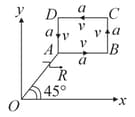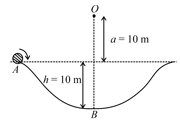MEDIUM
Earn 100
If earth shrink to half its present diameter without any change in its mass, the duration of the day will be
(a)48 h
(b)6 h
(c)12 h
(d)24 h
50% studentsanswered this correctly
Important Questions on Rotational Motion
HARD
HARD

Which of the following statements is false for the angular momentum about the origin?
MEDIUM
MEDIUM
HARD
MEDIUM
MEDIUM
A cubical block of side is moving with velocity on a smooth horizontal surface. The surface has a bump at a point as shown in the figure. The angular velocity (in rad/s) of the block immediately after it hits the bump, is :

MEDIUM
EASY
HARD
HARD
MEDIUM
HARD

HARD

EASY
A particle is moving uniformly along a straight line as shown in the figure. During the motion of the particle from to , the angular momentum of the particle about

EASY
MEDIUM
EASY
EASY
MEDIUM
A particle of mass is on a smooth horizontal table and moves in a circular path of radius . The height of the table from the ground is . If the angular speed of the particle is , the magnitude of its angular momentum about a point on the ground right under the center of the circle is:

